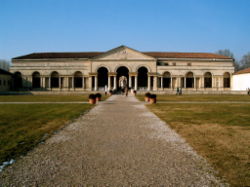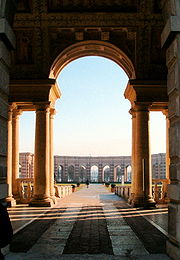
Palazzo del Te
Encyclopedia



Mantua
Mantua is a city and comune in Lombardy, Italy and capital of the province of the same name. Mantua's historic power and influence under the Gonzaga family, made it one of the main artistic, cultural and notably musical hubs of Northern Italy and the country as a whole...
, Italy
Italy
Italy , officially the Italian Republic languages]] under the European Charter for Regional or Minority Languages. In each of these, Italy's official name is as follows:;;;;;;;;), is a unitary parliamentary republic in South-Central Europe. To the north it borders France, Switzerland, Austria and...
. It is a fine example of the mannerist
Mannerism
Mannerism is a period of European art that emerged from the later years of the Italian High Renaissance around 1520. It lasted until about 1580 in Italy, when a more Baroque style began to replace it, but Northern Mannerism continued into the early 17th century throughout much of Europe...
style of architecture
Architecture
Architecture is both the process and product of planning, designing and construction. Architectural works, in the material form of buildings, are often perceived as cultural and political symbols and as works of art...
, the acknowledged masterpiece of Giulio Romano
Giulio Romano
Giulio Romano was an Italian painter and architect. A pupil of Raphael, his stylistic deviations from high Renaissance classicism help define the 16th-century style known as Mannerism...
. The official name, and by far the most common name in Italian, is Palazzo Te, but this may be a relatively recent usage; Vasari calls it the "Palazzo del T" , and English-speaking writers, especially art historians, continue to call it the Palazzo del Te. In Italian this now suggests use for tea-drinking, which may account for the divergence in usage.
Description
Palazzo del Te is a square building, constructed 1524-1534 for Federico II Gonzaga, Marquess of Mantua. He decided in 1524 to build a pleasure palacePalace
A palace is a grand residence, especially a royal residence or the home of a head of state or some other high-ranking dignitary, such as a bishop or archbishop. The word itself is derived from the Latin name Palātium, for Palatine Hill, one of the seven hills in Rome. In many parts of Europe, the...
, or Villa Suburbana. The site chosen was that of the family's stables at Isola del Te on the fringe of the marsh
Marsh
In geography, a marsh, or morass, is a type of wetland that is subject to frequent or continuous flood. Typically the water is shallow and features grasses, rushes, reeds, typhas, sedges, other herbaceous plants, and moss....
es just outside Mantua's city walls.
The architect commissioned was Giulio Romano
Giulio Romano
Giulio Romano was an Italian painter and architect. A pupil of Raphael, his stylistic deviations from high Renaissance classicism help define the 16th-century style known as Mannerism...
, a pupil of Raphael
Raphael
Raffaello Sanzio da Urbino , better known simply as Raphael, was an Italian painter and architect of the High Renaissance. His work is admired for its clarity of form and ease of composition and for its visual achievement of the Neoplatonic ideal of human grandeur...
. The shell of the palazzo was erected within 18 months. It is basically a square house built around a cloister
Cloister
A cloister is a rectangular open space surrounded by covered walks or open galleries, with open arcades on the inner side, running along the walls of buildings and forming a quadrangle or garth...
ed courtyard. A formal garden complemented the house. This was enclosed by colonnaded outbuildings terminated by a semi-circular colonnade known as the 'Esedra'
Exedra
In architecture, an exedra is a semicircular recess or plinth, often crowned by a semi-dome, which is sometimes set into a building's facade. The original Greek sense was applied to a room that opened onto a stoa, ringed with curved high-backed stone benches, a suitable place for a philosophical...
.
Like the Villa Farnesina
Villa Farnesina
The Villa Farnesina is a Renaissance suburban villa in the Via della Lungara, in the district of Trastevere in Rome, central Italy.The villa was built for Agostino Chigi, a rich Sienese banker and the treasurer of Pope Julius II. Between 1506–1510, the Sienese artist and pupil of Bramante,...
in Rome
Rome
Rome is the capital of Italy and the country's largest and most populated city and comune, with over 2.7 million residents in . The city is located in the central-western portion of the Italian Peninsula, on the Tiber River within the Lazio region of Italy.Rome's history spans two and a half...
, the suburb
Suburb
The word suburb mostly refers to a residential area, either existing as part of a city or as a separate residential community within commuting distance of a city . Some suburbs have a degree of administrative autonomy, and most have lower population density than inner city neighborhoods...
an location allowed for a mixing of both Palace and Villa
Villa
A villa was originally an ancient Roman upper-class country house. Since its origins in the Roman villa, the idea and function of a villa have evolved considerably. After the fall of the Roman Republic, villas became small farming compounds, which were increasingly fortified in Late Antiquity,...
architecture. The four exterior façades have flat pilasters against rusticated
Rustication (architecture)
thumb|upright|Two different styles of rustication in the [[Palazzo Medici-Riccardi]] in [[Florence]].In classical architecture rustication is an architectural feature that contrasts in texture with the smoothly finished, squared block masonry surfaces called ashlar...
walls, the fenestration indicating that the piano nobile
Piano nobile
The piano nobile is the principal floor of a large house, usually built in one of the styles of classical renaissance architecture...
is on the ground floor with a secondary floor above. The East façade differs from the other three by having Palladian motifs on its pilaster and an open loggia
Loggia
Loggia is the name given to an architectural feature, originally of Minoan design. They are often a gallery or corridor at ground level, sometimes higher, on the facade of a building and open to the air on one side, where it is supported by columns or pierced openings in the wall...
at its centre rather than an arch to the courtyard. The facades are not as symmetrical as they appear, and the spans between the columns are irregular. The centre of the North and South facades are pierced by two-storey arches without portico or pediment, simply a covered way leading to the interior courtyard.
Few windows overlook the inner courtyard ("cortile"); the colonnaded walls are decorated on all sides by deep niches and blind windows, and the intervening surfaces are spattered by 'spezzato' (broken and blemished plaster) giving life and depth to the surfaces.
Once the shell of the building was completed, for ten years a team of plasterers, carvers and fresco painters laboured, until barely a surface in any of the loggias or salons remained undecorated. Under Giulio Romano's direction, local decorative painters such as Benedetto Pagni
Benedetto Pagni
Benedetto Pagni was an Italian painter of the Mannerist period, active mainly in Mantua and Pescia. He was part of the team of assistants of Giulio Romano in the decoration of the Palazzo del Te. He painted a Martyrdom of San Lorenzo for the church of Sant'Andrea. He painted a Marriage of Cana for...
and Rinaldo Mantovano worked extensively on the frescos. These frescoes remain today and are the most remarkable feature of the Palazzo. The subjects range from Olympian
Twelve Olympians
The Twelve Olympians, also known as the Dodekatheon , in Greek mythology, were the principal deities of the Greek pantheon, residing atop Mount Olympus. Zeus, Hera, Poseidon, Demeter, Hestia, and Hades were siblings. Ares, Hermes, Hephaestus, Athena, Apollo, and Artemis were children of Zeus...
banquet
Banquet
A banquet is a large meal or feast, complete with main courses and desserts. It usually serves a purpose such as a charitable gathering, a ceremony, or a celebration, and is often preceded or followed by speeches in honour of someone....
s in the Sala di Psiche and stylised horse
Horse
The horse is one of two extant subspecies of Equus ferus, or the wild horse. It is a single-hooved mammal belonging to the taxonomic family Equidae. The horse has evolved over the past 45 to 55 million years from a small multi-toed creature into the large, single-toed animal of today...
s in the Sala dei Cavalli to the most unusual of all — giants
Giant (mythology)
The mythology and legends of many different cultures include monsters of human appearance but prodigious size and strength. "Giant" is the English word commonly used for such beings, derived from one of the most famed examples: the gigantes of Greek mythology.In various Indo-European mythologies,...
and grotesque
Grotesque
The word grotesque comes from the same Latin root as "Grotto", meaning a small cave or hollow. The original meaning was restricted to an extravagant style of Ancient Roman decorative art rediscovered and then copied in Rome at the end of the 15th century...
s wreaking havoc, fury and ruin around the walls of the Sala dei Giganti.
These magnificent rooms, once furnished to complement the ducal court of the Gonzaga
House of Gonzaga
The Gonzaga family ruled Mantua in Northern Italy from 1328 to 1708.-History:In 1433, Gianfrancesco I assumed the title of Marquis of Mantua, and in 1530 Federico II received the title of Duke of Mantua. In 1531, the family acquired the Duchy of Monferrato through marriage...
family, saw many of the most illustrious figures of their era entertained such as the Emperor Charles V, who, when visiting in 1530, elevated his host Federico II of Gonzaga from Marquess to Duke of Mantua.
One of the most evocative parts of the lost era of the palazzo is the Casino della Grotta, a small suite of intimate rooms arranged around a grotto
Grotto
A grotto is any type of natural or artificial cave that is associated with modern, historic or prehistoric use by humans. When it is not an artificial garden feature, a grotto is often a small cave near water and often flooded or liable to flood at high tide...
and loggetta (covered balcony) where courtier
Courtier
A courtier is a person who is often in attendance at the court of a king or other royal personage. Historically the court was the centre of government as well as the residence of the monarch, and social and political life were often completely mixed together...
s once bathed in the small cascade that splashed over the pebble
Pebble
A pebble is a clast of rock with a particle size of 4 to 64 millimetres based on the Krumbein phi scale of sedimentology. Pebbles are generally considered to be larger than granules and smaller than cobbles . A rock made predominantly of pebbles is termed a conglomerate...
s and shells encrusted in the floor and walls.
In 1630 Mantua and the palace were sacked by invading forces, the remaining population fell victim to one of the worst plague
Bubonic plague
Plague is a deadly infectious disease that is caused by the enterobacteria Yersinia pestis, named after the French-Swiss bacteriologist Alexandre Yersin. Primarily carried by rodents and spread to humans via fleas, the disease is notorious throughout history, due to the unrivaled scale of death...
s in history. The Palazzo was looted from top to bottom and remained an empty shell: nymphs, god, goddesses and giants remain on the walls of the empty echoing rooms.
Part of the Palazzo today houses the Museo Civico del Palazzo Te, endowed by the publisher Arnoldo Mondadori
Arnoldo Mondadori
Arnoldo Mondadori was a noted Italian publisher.Mondadori was born at Poggio Rusco, Mantua and died in Milan.His publishing house is today the largest in Italy.-External links:*...
. It contains a collection of Mesopotamian art.
External links
- Guided Tours in Mantua
- Official website
- Mantua tourist guide Mantua tourist guide

